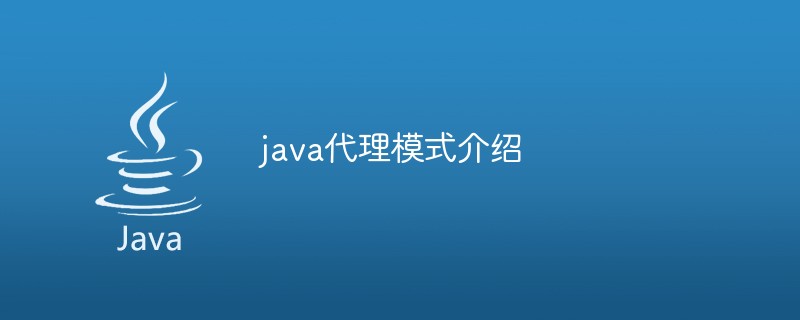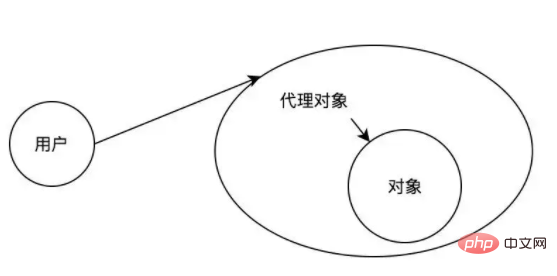
Let’s first introduce what an agent is.
(Learning video sharing: java video tutorial)
Proxy is a design pattern. Its core idea is to transfer access to the target to the proxy object . The advantage of this is that the target object can add some additional functions through the proxy object without changing the code. This is a programming idea that adds some extended functions through agents without changing the original code.
The proxy process is as shown in the figure. The user accesses the proxy object, and the proxy object achieves the purpose of the user accessing the target object by accessing the target object.

Proxy The pattern contains the following three roles:
ISubject: Interface object, which is the interface shared by the object and its proxy.
TargetSubject: The target object is a class that implements the abstract theme interface.
Proxy: Proxy role, which contains a reference to the target object TargetSubject, so that the real object can be manipulated. The proxy object provides the same interface as the target object so that it can replace the target object at any time. At the same time, the proxy object can add other operations when performing operations on the target object, which is equivalent to encapsulating the real object.
Common proxy modes are divided into static proxy and dynamic proxy. The implementation of dynamic proxy in Java is divided into JDK dynamic proxy and cglib proxy.
Static Proxy
As mentioned before, there are three roles in the proxy mode, one is the target interface, the second is the target object, and the third is the proxy object.
Now implement it with specific code. First, the target interface is as follows:
public interface IBlogService {
void writeBlog();
}The target object implements the target interface, the code is as follows:
public class BlogService implements IBlogService {
@Override
public void writeBlog() {
System.out.println("i'm writing...");
}
}Static proxy object, through the constructor method The target object is obtained and the target interface is implemented. The method of the target object is called in the method of the target interface. The code is as follows:
public class BlogStaticProxy implements IBlogService{
private IBlogService blogService;
public BlogStaticProxy(IBlogService blogService) {
this.blogService = blogService;
}
@Override
public void writeBlog() {
System.out.println("start writing...");
blogService.writeBlog();
System.out.println("end writing...");
}
}Static proxy object, the target object is obtained through the construction method and the goal is achieved. Interface, the method of the target object is called in the method of the target interface, the code is as follows:
public class BlogStaticProxy implements IBlogService{
private IBlogService blogService;
public BlogStaticProxy(IBlogService blogService) {
this.blogService = blogService;
}
@Override
public void writeBlog() {
System.out.println("start writing...");
blogService.writeBlog();
System.out.println("end writing...");
}
}Test:
public class TestStaticProxy {
public static void main(String[] args) {
IBlogService target = new BlogService();
BlogStaticProxy proxy = new BlogStaticProxy(target);
proxy.write();
}
}start writing… i’m writing… end writing…
Static proxy, without modifying the target object, you can pass the proxy object Make additional extension functions. But static methods are not very flexible. If the code of the target interface is modified, both the target object and the proxy object need to be modified.
Dynamic proxy avoids this situation to a certain extent. Dynamic proxy does not require the proxy object to implement the target interface, and dynamically generates the proxy object in the memory of the java virtual machine
Jdk dynamic object
Jdk's dynamic proxy is generated by the Proxy class, which has three parameters:
ClassLoader loader,: specifies the current target object to use the class loader, and the method of obtaining the loader is fixed
Class[] interfaces,: The type of interface implemented by the target object, use generics to confirm the type
InvocationHandler h: Event processing, will be triggered when the method of the target object is executed The method of the event handler will pass the method of the current execution target object as a parameter into
public static Object newProxyInstance(ClassLoader loader,
Class<?>[] interfaces,
InvocationHandler h)
throws IllegalArgumentException
{
}The dynamic proxy code of Jdk is as follows:
public class JdkBlogProxyFactory {
private Object target;
public JdkBlogProxyFactory(Object target) {
this.target = target;
}
public Object newInstance() {
return Proxy.newProxyInstance(target.getClass().getClassLoader(), target.getClass().getInterfaces(),
(proxy, method, args) -> {
System.out.println("start writing");
Object o = method.invoke(target, args);
System.out.println("end writing");
return o;
});
}
}Test class:
public class TestJdkProxy {
public static void main(String[] args) {
IBlogService target = new BlogService();
System.out.println(target.getClass());
// 給目標(biāo)對象,創(chuàng)建代理對象
IBlogService proxy = (IBlogService) new JdkBlogProxyFactory(target).newInstance();
// class $Proxy0 內(nèi)存中動態(tài)生成的代理對象
System.out.println(proxy.getClass());
// 執(zhí)行方法 【代理對象】
proxy.writeBlog();
}
}Control The Taiwan print is as follows:
class com.forezp.proxy.BlogService class com.sun.proxy.$Proxy0 start writing i'm writing... end writing
CGLib dynamic proxy
CGLib uses a very low-level bytecode technology. The principle is to create a subclass for a class through bytecode technology, and use it in the subclass The method interception technology is used to intercept all calls to parent class methods and weave in cross-cutting logic accordingly.
CglibBlogFactory proxy factory class is as follows:
public class CglibBlogFactory implements MethodInterceptor {
private Object target;
public CglibBlogFactory(Object target) {
this.target = target;
}
//給目標(biāo)對象創(chuàng)建一個(gè)代理對象
public Object getProxyInstance() {
//1.工具類
Enhancer en = new Enhancer();
//2.設(shè)置父類
en.setSuperclass(target.getClass());
//3.設(shè)置回調(diào)函數(shù)
en.setCallback(this);
//4.創(chuàng)建子類(代理對象)
return en.create();
}
@Override
public Object intercept(Object o, Method method, Object[] objects, MethodProxy methodProxy) throws Throwable {
System.out.println("start writing...");
//執(zhí)行目標(biāo)對象的方法
Object returnValue = method.invoke(target, objects);
System.out.println("end writing...");
return returnValue;
}
}Test class:
public class TestCglib {
public static void main(String[] args) {
IBlogService target = new BlogService();
//代理對象
IBlogService proxy = (IBlogService) new CglibBlogFactory(target).getProxyInstance();
//執(zhí)行代理對象的方法
proxy.writeBlog();
}
}Run the program, console printing:
start writing... i'm writing... end writing...
Related recommendations: java Getting Started Tutorial
The above is the detailed content of Introduction to java proxy mode. For more information, please follow other related articles on the PHP Chinese website!

Hot AI Tools

Undress AI Tool
Undress images for free

Undresser.AI Undress
AI-powered app for creating realistic nude photos

AI Clothes Remover
Online AI tool for removing clothes from photos.

Clothoff.io
AI clothes remover

Video Face Swap
Swap faces in any video effortlessly with our completely free AI face swap tool!

Hot Article

Hot Tools

Notepad++7.3.1
Easy-to-use and free code editor

SublimeText3 Chinese version
Chinese version, very easy to use

Zend Studio 13.0.1
Powerful PHP integrated development environment

Dreamweaver CS6
Visual web development tools

SublimeText3 Mac version
God-level code editing software (SublimeText3)
 VSCode settings.json location
Aug 01, 2025 am 06:12 AM
VSCode settings.json location
Aug 01, 2025 am 06:12 AM
The settings.json file is located in the user-level or workspace-level path and is used to customize VSCode settings. 1. User-level path: Windows is C:\Users\\AppData\Roaming\Code\User\settings.json, macOS is /Users//Library/ApplicationSupport/Code/User/settings.json, Linux is /home//.config/Code/User/settings.json; 2. Workspace-level path: .vscode/settings in the project root directory
 How to handle transactions in Java with JDBC?
Aug 02, 2025 pm 12:29 PM
How to handle transactions in Java with JDBC?
Aug 02, 2025 pm 12:29 PM
To correctly handle JDBC transactions, you must first turn off the automatic commit mode, then perform multiple operations, and finally commit or rollback according to the results; 1. Call conn.setAutoCommit(false) to start the transaction; 2. Execute multiple SQL operations, such as INSERT and UPDATE; 3. Call conn.commit() if all operations are successful, and call conn.rollback() if an exception occurs to ensure data consistency; at the same time, try-with-resources should be used to manage resources, properly handle exceptions and close connections to avoid connection leakage; in addition, it is recommended to use connection pools and set save points to achieve partial rollback, and keep transactions as short as possible to improve performance.
 Mastering Dependency Injection in Java with Spring and Guice
Aug 01, 2025 am 05:53 AM
Mastering Dependency Injection in Java with Spring and Guice
Aug 01, 2025 am 05:53 AM
DependencyInjection(DI)isadesignpatternwhereobjectsreceivedependenciesexternally,promotingloosecouplingandeasiertestingthroughconstructor,setter,orfieldinjection.2.SpringFrameworkusesannotationslike@Component,@Service,and@AutowiredwithJava-basedconfi
 Understanding the Java Virtual Machine (JVM) Internals
Aug 01, 2025 am 06:31 AM
Understanding the Java Virtual Machine (JVM) Internals
Aug 01, 2025 am 06:31 AM
TheJVMenablesJava’s"writeonce,runanywhere"capabilitybyexecutingbytecodethroughfourmaincomponents:1.TheClassLoaderSubsystemloads,links,andinitializes.classfilesusingbootstrap,extension,andapplicationclassloaders,ensuringsecureandlazyclassloa
 How to work with Calendar in Java?
Aug 02, 2025 am 02:38 AM
How to work with Calendar in Java?
Aug 02, 2025 am 02:38 AM
Use classes in the java.time package to replace the old Date and Calendar classes; 2. Get the current date and time through LocalDate, LocalDateTime and LocalTime; 3. Create a specific date and time using the of() method; 4. Use the plus/minus method to immutably increase and decrease the time; 5. Use ZonedDateTime and ZoneId to process the time zone; 6. Format and parse date strings through DateTimeFormatter; 7. Use Instant to be compatible with the old date types when necessary; date processing in modern Java should give priority to using java.timeAPI, which provides clear, immutable and linear
 Google Chrome cannot open local files
Aug 01, 2025 am 05:24 AM
Google Chrome cannot open local files
Aug 01, 2025 am 05:24 AM
ChromecanopenlocalfileslikeHTMLandPDFsbyusing"Openfile"ordraggingthemintothebrowser;ensuretheaddressstartswithfile:///;2.SecurityrestrictionsblockAJAX,localStorage,andcross-folderaccessonfile://;usealocalserverlikepython-mhttp.server8000tor
 Understanding Network Ports and Firewalls
Aug 01, 2025 am 06:40 AM
Understanding Network Ports and Firewalls
Aug 01, 2025 am 06:40 AM
Networkportsandfirewallsworktogethertoenablecommunicationwhileensuringsecurity.1.Networkportsarevirtualendpointsnumbered0–65535,withwell-knownportslike80(HTTP),443(HTTPS),22(SSH),and25(SMTP)identifyingspecificservices.2.PortsoperateoverTCP(reliable,c
 Comparing Java Frameworks: Spring Boot vs Quarkus vs Micronaut
Aug 04, 2025 pm 12:48 PM
Comparing Java Frameworks: Spring Boot vs Quarkus vs Micronaut
Aug 04, 2025 pm 12:48 PM
Pre-formanceTartuptimeMoryusage, Quarkusandmicronautleadduetocompile-Timeprocessingandgraalvsupport, Withquarkusoftenperforminglightbetterine ServerLess scenarios.2.Thyvelopecosyste,






